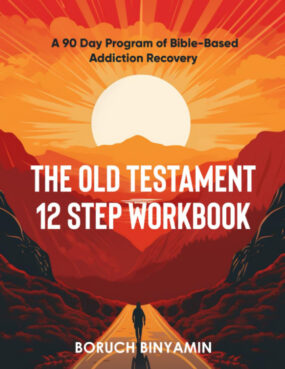(RNS) — At one of the first Alcoholics Anonymous meetings Boruch Binyamin attended, a Christian man opened up about how the Bible was of very little help to people struggling with substance abuse, adding that recovering addicts couldn’t learn anything from stories like Noah’s Ark.
As a practicing Jew, Binyamin couldn’t relate.
“I remember thinking you’re mistaken, that story of Noah’s Ark could tell you a lot about getting sober,” he said.
Twenty-three years have passed since the meeting, and Binyamin’s life has changed a lot. He used to be a “high-bottom” drunk in AA jargon: someone who lived a fairly normal life while secretly consuming alcohol in unhealthy ways. Today, after nearly a quarter-century sober, the 58-year-old man helps others overcome alcohol addiction using verses from the Torah.
His new book, “The Old Testament 12 step workbook: A 90 day program of Bible-Based addiction recovery,” published under the pen name Boruch Binyamin for privacy concerns, is a 30-day program with daily reflection exercises, drawing on AA’s famous 12-step method and portions of the Jewish Scripture.

“The Old Testament 12 Step Workbook: A 90 Day Program of Bible-Based Addiction Recovery” by Boruch Binyamin. (Courtesy image)
Every prompt is an invitation to meditate on the stories and reflect on how those stories echo their experiences as recovering alcoholics.
The book is infused with teachings of prominent Jewish philosophers. The 11th-century French Rabbi Shlomo Yitzchaki, who ran Troyes rabbinical court, and the 12th-century Shepardic rabbi and philosopher Maimonides, had the most influence on his work, said Binyamin.
The fifth lesson of the program is a direct nod to his fellow AA friend, as it focuses on the story of Noah’s Ark. Many Jewish scholars think God’s command to Noah to create a window on top of the ark, one that will let daylight enter but wouldn’t let him witness the chaos happening outside, is a sign that he was “enough of a righteous man to be saved from the flood, but not righteous enough to be worthy of witnessing the destruction of the world.”
In his workbook, Binyamin makes the case that this story speaks to the journeys of recovering alcoholics. Just like Noah, they shouldn’t expose themselves to traumatic and stressful situations that might trigger a craving for alcohol. The journaling section that follows suggests three “questions to ponder,” inviting readers to identify sources of stress that might lead them to turn to substance abuse.
“That’s the thought process that I want people to go through because I think it’ll help them,” he said.
Binyamin said he created the book for other religious recovering addicts who, like him, didn’t connect with the AA program’s concept of religiosity. Founded in 1935 by Bill Wilson, who claimed to be a “conservative atheist,” and Bob Smith, a Christian, the AA program is infused with spirituality but isn’t tied to any one religion. In the hopes of welcoming everyone, regardless of their faith, AA celebrates a divine figure that participants can assign their own beliefs to.
Published in 1939, the “Big Book” is one of the main tools of the program and includes the recovery stories of the first 100 members of the group. It is packed with references to a non-theological “Higher Power,” explained Binyamin. The AA’s 12-step method also refers to a “Power greater than ourselves” that “could restore us to sanity.”
Often meeting in church basements, the organization is sometimes mistaken for being affiliated with Christianity.
“It’s important to remember that A.A. is not a religious organization; we have a simple idea that there is a power greater than us as individuals,” read a 2023 statement from the group.
The concept certainly works for non-religious people, said Binyamin, but didn’t resonate with his own understanding of God and felt too generic. The idea of a God to whom they were invited to throw their problems at unsettled him. “As a Jewish person, that made no sense to me at all,” he said.
In his book, he tries to reconcile AA’s ethos with his own religious culture, although relying on his faith during the recovery journey didn’t always come naturally, he explained. For a long time, Binyamin was ashamed of his addiction to alcohol, a taboo topic in the Jewish community.
“It’s shocking, and people are thinking, ‘well that’s not supposed to be happening.’ Well, it’s happening,” he said.
It’s also less of a problem in the Jewish community. Jews have a significantly lower rate of alcoholism than the general population does. “More than 7% of the adult United States population are alcoholic, but less than 1% of the adult Jewish population is so classified,” wrote Barry Glassner and Bruce Berg in their paper, How Jews avoid alcohol problems.
In 1958, psychologist Charles R. Snyder studied drinking habits in the Jewish community of New Haven, Connecticut. Because drinking is a ritualized practice in Judaism, alcohol consumption is seen as more “instrumental,” as it’s often part of a religious ceremony, he explained.
Now, Binyamin, who is Orthodox and goes to synagogue every week, is convinced his spiritual practice has helped him to stay sober and hopes to inspire others on the same path.
To this day, he still applies the methods he listed in his book and goes to AA meetings weekly.
“The truth is, it’s kind of a never-ending process,” he said.





